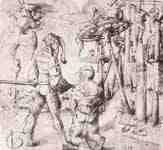Urs Graf
Paintings

Drawings
Bust of a Bearded Old Man
Margarita Philosophica



Urs Graf (born c. 1485 in Solothurn, Switzerland; possibly died before 13 October 1528) was a Swiss Renaissance goldsmith, painter and printmaker (of woodcuts, etchings and engravings), as well as a mercenary soldier. He only produced two etchings, one of which dates from 1513 – the earliest known etching for which a date has been established. However, his woodcuts are considered of greater significance, particularly as he is attributed with the invention of the white-line woodcut technique, where white lines create the image on a black background. He also produced a few engravings, including copies of works by Martin Schongauer and Albrecht Dürer. He produced innovative drawings intended as finished works of art rather than just studies.
Biography
Graf learned goldsmithing first from his father, Hugo Graf, then from a goldsmith in Zürich. He continued to work as a goldsmith and a few pieces survive. He initially earned money as a designer of woodcut book illustrations and by assisting a stained glass painter. In 1512, he bought citizenship in Basel and became a member of the goldsmiths' guild. He quickly came into conflict with the law for abusing his wife and consorting with prostitutes, culminating in accusations of attempted murder which caused him to flee the city in 1518. He was allowed to return to Basel the following year, where he continued working, but after 1527 his life becomes unclear. Given his frequent employment as a soldier of fortune it is possible he was present at the sack of Rome.[3] Christiane Andersson noted that, "When and where he died are unknown: his wife remarried in October 1528 but an autograph drawing is dated 1529".[4]
Like many Swiss men of his day, Graf was known to have worked as a mercenary for considerable periods. His artistic output, arising from the tradition of Albrecht Dürer and Hans Baldung, includes a wide range of subjects, depicting social, erotic, military, political, and criminal images (e.g., Two Prostitutes Beating a Monk), as well as strong religious feelings which emerge in some works.[4]
References
Martin Rohde: Graf, Urs (der Ältere) in German, French and Italian in the online Historical Dictionary of Switzerland, 2005-12-01.
Arthur M. Hind. A History of Engraving and Etching. Houghton Mifflin Co., 1923 (in US), reprinted Dover Publications, 1963. ISBN 0-486-20954-7
P. Murray & L. Murray, 'The Penguin Dictionary of Art & Artists' (p.198 section G) Harmondsworth, 1959 (1982 revision)
Andersson
Christiane Andersson. "Graf, Urs." Grove Art Online. Oxford Art Online. Oxford University Press. Web. 26 Feb. 2013. [1]
---
Fine Art Prints | Greeting Cards | Phone Cases | Lifestyle | Face Masks | Men's , Women' Apparel | Home Decor | jigsaw puzzles | Notebooks | Tapestries | ...
---
Artist
A - B - C - D - E - F - G - H - I - J - K - L - M -
N - O - P - Q - R - S - T - U - V - W - X - Y - Z
Retrieved from "http://en.wikipedia.org/"
All text is available under the terms of the GNU Free Documentation License




